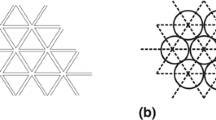Abstract
In this paper a numerical model is presented for simulating fracture in heterogeneous materials such as concrete and rock. The typical failure mechanism, crack face bridging, found in concrete and other materials is simulated by use of a lattice model. The model can be used at a small scale, where the particles in the grain structure are generated and aggregate, matrix and bond properties are assigned to the lattice elements. Simulations at this scale are useful for studying the influence of material composition. In addition the model seems a promising tool for simulating fracture in structures. In this case the microstructure of the material is not mimicked in detail but rather the lattice elements are given tensile strengths which are randomly chosen out of a certain distribution. Realistic crack patterns are found compared with experiments on laboratory-scale specimens. The present results indicate that fracture mechanisms are simulated realistically. This is very important because it simplifies the tuning of the model.
Resume
Dans cet article on présente un modèle numérique de simulation de rupture dans les matériaux hétérogènes tels que bétons et roches. Le mécanisme de rupture typique par pont de fissuration en surface, qui se rencontre dans le béton et d'autres matériaux, est simulé à l'aide d'un modèle réticulaire qu'on peut utiliser à une échelle réduite là où les particules sont définies dans la structure granulaire, et les propriétés du granulat, de la matrice et de l'adhérence sont assumées par les éléments du réseau. Des simulations à cette échelle sont utiles pour étudier l'influence de la composition du matériau. En outre, le modèle paraît un outil prometteur pour simuler la rupture dans les structures. En ce cas, on n'imite pas la microstructure du matériau dans le détail, on préfère attribuer aux éléments du treillis des résistances à la traction prises au hasard d'une certaine distribution. On compare des modèles réalistes de fissuration à des essais sur des éprouvettes à léchelle du laboratoire. Les résultats actuels montrent que les mécanismes de rupture sont simulés de façon réaliste, ce qui est très important, car cela simplifie l'ajustement du modèle.
Similar content being viewed by others
References
van Mier, J. G. M., ‘Internal crack detection in single edge notched concrete plates subjected to uniform boundary displacements’, in ‘Micromechanics of Failure of Quasi-Brittle Materials’ edited by S. P. Shah, S. E. Swartz and M. L. Wang (Elsevier Applied Science, London, 1990) pp. 33–42.
Herrmann, H. J. and Roux, S., ‘Modelization of fracture in disordered systems’, in ‘Statistical Models for the Fracture of Disordered Media’, edited by H. J. Herrmann and S. Roux (Elsevier Science/North-Holland, Amsterdam 1990) pp. 159–188.
Walraven, J. C., ‘Aggregate Interlock: a Theoretical and Experimental Analysis’, Ph.D thesis, Delft University of Technology (1980).
Hsu, T. T. C., ‘Mathematical analysis of shrinkage stresses in a model of hardened concrete’,ACI J. 60(3) (1963) 371–390.
van Mier, J. G. M., ‘Mode I fracture of concrete: discontinuous crack growth and crack interface grain bridging’,Cement Concr. Res. 21, (1991) 1–15.
Idem, ‘Crack face bridging in normal, high strength and lytag concrete’, in ‘Fracture Processes in Concrete, Rock and Ceramics’, edited by J. G. M. van Mier, J. G. Rots and A. Bakker (Chapman and Hall, London, 1991) pp. 27–40.
Sempere, J.-C. and Macdonald, K. C., ‘Overlapping spreading centres: implication from crack growth simulation by the displacement discontinuity method’,Tectonics 5 (1986) 151–163.
Schlangen, E. and van Mier, J. G. M. ‘Experimental and Numerical Analysis of Micromechanisms of Fracture of Cement-based Composites’, Report No. 25.5-91-1/VFC (Delft University of Technology, 1991), also inCement Concr. Compos., guest editor V. C. Li14, No. 2 (1992).
Idem, ‘Boundary effects in mixed mode I and II fracture of concrete’, in ‘Fracture Processes in Concrete, Rock and Ceramics’, edited by J. G. M. van Mier, J. G. Rots and A. Bakker (Chapman and Hall, London, 1991) pp. 705–716.
Carpinteri, A., Ferrara, G. and Melchiorri, G., ‘Single edge notched specimen subjected to four point shear: an experimental investigation,’ in ‘Fracture of Concrete and Rock, Recent Developments’, edited by S. P. Shah, S. E. Swartz and B. Barr (Elsevier Applied Science, London, 1989) pp. 605–614.
Rots, J. G., ‘Computational modeling of concrete fracture’, Ph.D. thesis, Delft University of Technology (1988).
Ballarini, R. and Shah, S. P., ‘Fracture mechanics based analyses of pull-out tests and anchor bolts’, in ‘Analysis of Concrete Structures by Fracture Mechanics’, edited by L. Elfgren and S. P. Shah (Chapman and Hall, London, 1989) pp. 245–280.
Elfgren, L., ‘Round robin analysis of anchor bolts—invitation, RILEM TC90 FMA’,Mater. Struct. 23 (1990) 78.
Schlangen, E. and van Mier, J. G. M., ‘Round robin analysis of anchor bolts’, contribution to the round robin proposal of RILEM TC90 FMA, in ‘Fracture Mechanics of Concrete-Applications’, report compiled at the Luleå University of Technology, edited by L. Elfgren (1991) pp. 15:1–15:5.
Helbling, A., Alvaredo, A. M. and Wittmann, F. H., ‘Round robin test of anchor bolts’, contribution to the round robin proposal of RILEM TC90 FMA,ibid. in ‘Fracture Mechanics of Concrete-Applications’, report compiled at the Luleå University of Technology, edited by L. Elfgren (1991) pp. 8:1–8:22.
Author information
Authors and Affiliations
Rights and permissions
About this article
Cite this article
Schlangen, E., van Mier, J.G.M. Simple lattice model for numerical simulation of fracture of concrete materials and structures. Materials and Structures 25, 534–542 (1992). https://doi.org/10.1007/BF02472449
Issue Date:
DOI: https://doi.org/10.1007/BF02472449




